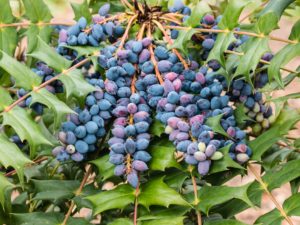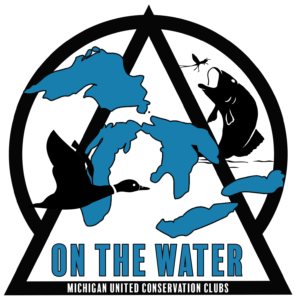Oregon Grape
The invasive species Oregon Grape is an evergreen shrub that may reach 4 to 6 feet in height and 3 to 4 feet in width. This shrub has large, pinnately compound leaves with 9 to 13 spiny leaflets. The shrub is multi-stemmed and the bark is corky. Fragrant, yellow flowers appear in winter. Small, black fruits hang in grape-like clusters and mature in May and June. Oregon Grape likes to take root in partial shade and moist soils. This invasive shrub colonizes by seeds that are dispersed by birds and mammals.
 So far this invasive species hasn’t taken root that much in the great lakes state but is taking hold in other parts of the world like Europe. When comparing different treatment methods of eradicating invasive species which include manual removal and, herbicide application scientists reported herbicide leaf treatment is the most effective method. Manual removal by digging and treating stems with the herbicide chemical glyphosate shows medium effectiveness. Treating stems with a saturated salt solution appeared rather cosmetic. However, it’s not that easy to choose which method would be the best to work with, since with herbicide use there are non-target effects on the environment, economy, and society to be considered.
So far this invasive species hasn’t taken root that much in the great lakes state but is taking hold in other parts of the world like Europe. When comparing different treatment methods of eradicating invasive species which include manual removal and, herbicide application scientists reported herbicide leaf treatment is the most effective method. Manual removal by digging and treating stems with the herbicide chemical glyphosate shows medium effectiveness. Treating stems with a saturated salt solution appeared rather cosmetic. However, it’s not that easy to choose which method would be the best to work with, since with herbicide use there are non-target effects on the environment, economy, and society to be considered.
MUCC’s On the Water program is working with Kitchel-Lindquist-Hartger Dunes Preserve to target this invasive that is possibly taking residency in this dunes preserve along Lake Michigan. Keep a lookout for an invasive species removal project coming soon in this area!
 On the Water’s funding from Consumers Energy’s Planet grant comes to an end this September. If you like what
On the Water’s funding from Consumers Energy’s Planet grant comes to an end this September. If you like what OTW is creating and want this program to continue please let us know! OTW unquestionably wants to advance as a program, connect and form partnerships that improve watersheds around the state of Michigan, but we can’t do this without your support.
OTW is creating and want this program to continue please let us know! OTW unquestionably wants to advance as a program, connect and form partnerships that improve watersheds around the state of Michigan, but we can’t do this without your support.
The post Oregon Grape appeared first on Michigan United Conservation Clubs.



